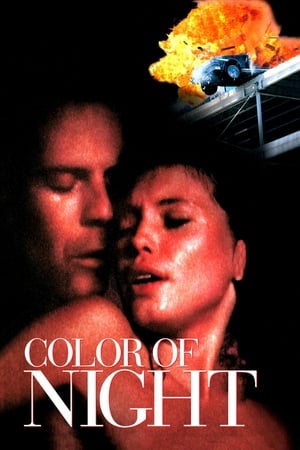
Color of Night
ust when you thought they'd never make a mystery thriller as deliriously bad as Midnight Lace, just when you imagined that the gold lame spirit of Douglas Sirk had departed forever, comes director Richard Rush's COLOR OF NIGHT to brighten up your dull evenings. Color of Night isn't just bad: it's bad with raisins in it. If you were one of the few who saw Color of Night in a theater, you probably remember the plot, but for those millions and millions who missed this gem, let's recap. Bruce Willis stars as a psychologist. (Are you laughing too hard or can we go on now?) Willis is having a crisis of conscience/ confidence because one of his patients leaped out of a window after applying lots of lipstick. (We all know, don't we, that applying lots of lipstick is a sure sign of suicidal depression?) Anyway, Willis goes out to L.A. to visit fellow shrink Scott Bakula, who takes Willis to his group therapy session so that the fun can start in earnest. Remember "The Bob Newhart Show" from the '70's? His group therapy meetings weren't nearly as funny as these: we have a nympho, an obsessive-compulsive, a split personality, the Professor and Mary Ann -- well, you get the idea. Bakula gets killed in a scene that looks like Psycho directed by Mack Sennett. The sad part is that Bakula is the most talented and attractive member of the whole goddamn cast and 30 minutes into the picture he's been bumped off. Willis stays on in Bakula's grandiosely modern home (crammed with screamingly bad art) despite the fact that someone keeps stalking him and leaving snakes in the mailbox. (Are hotels in L.A. that expensive?) It's like the TV movie where that devil doll keeps chasing Karen Black around her apartment going, "Yanni yanni yanni," and it never occurs to her to just leave.Instead of ruining the horribly implausible and helter-skelter plot for you, We'll just point out some of the more outrageous lapses of sanity: a) Willis's patient jumps out of a Manhattan office tower, causing pedestrians to scream and run, whereas real New Yorkers would have lifted her purse; b) Three days after famous psychologist Scott Bakula is killed in an exceedingly colorful way in his midtown office, his patients still don't know about it -- okay, we've already established that there are no reasonably priced hotels in L.A., but surely there must be at least one newspaper or TV station; c) The whole plot hook -- Willis goes color blind after seeing his patient's blood -- goes nowhere. Period. You keep thinking there has to be a reason for it or a plot twist that depends on it -- but nothing ever happens. The film is a laugh riot and we don't want to give away all of the jokes. When we saw the film in the theater, the audience laughed all the way through the first sex scene, which took place underwater and was about as erotic as an Esther Williams movie. Oh, yes, we do get to see generous portions of Bruce Willis, though not as much as he'd have liked. Then there's the acting. Even the extras overact. Keep your eyes out for one unbilled woman playing a hooker in a police station. She only has one line, but she gives it such gusto that she will leave you stunned. Even formerly respected actors lose all sense of self-control; Lesley Ann Warren (decked out in a Shelley Long wig) twitches and twitters like a road company Billie Burke, and Ruben Blades does what appears to be a Jose Jimenez imitation. Willis actually seems like a model of intelligent understatement compared with the rest of the cast, but the truth is, he just wasn't acting at all. And then there's Jane March. Ever so much of Jane March. Watching her try to match wits with Bruce Willis really makes you appreciate the bang-up job Cybill Shepherd was doing all those years. Jane spends half the movie dressed in disguise as a teenage boy. (How hard is she to spot? She's got teeth like Bucky Beaver! This gal could eat corn on the cob through a picket fence!) It all just gets sillier and sillier until the grand finale, which tried to come off as Hitchcockian but reminded us more of silent film legend Harold Lloyd. Judging by the guffaws from the audience, we weren't alone. So, watch Color of Night if you're feeling down in the mouth. Just don't try to eat popcorn during it -- unless you know the Heimlich maneuver.
